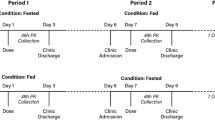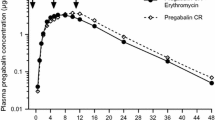Summary
The influence of time of drug administration on pharmacokinetics of theophylline was studied both after ingestion of a sustained-release tablet, containing choline theophyllinate (Zy 15061-S. R.; Teovent®; Sabidal®; ZYMA S.A.) and after intravenous infusion of aminophylline to eight healthy volunteers. Both drugs were administered in the morning (10 a.m.) and on a separate occasion in the evening (10 p.m.) after a 12 h period of fasting.
After oral administration of a dose of 540 mg theophylline, the drug was steadily absorbed, both during day-time and during night-time. In some subjects absorption was slower in the evening. Maximum theophylline plasma concentrations were reached after 3.3±0.4 h (mean±SD) and 3.9±1.4 h respectively (not significantly differentp>0.05).
The maximum plasma concentrations were almost identical after administration in the morning and in the evening (12.6±3.3 mg·l−1 and 13.1±1.4 mg·l−1 respectively).
There was also no significant difference (p>0.05) between the areas under the plasma concentration-time curves after oral and intravenous administration, both at day-time and at night-time. This finding indicates complete bioavailability of the sustained release tablets on both occasions.
After administration of the tablets in the morning the plasma concentration 12 h post dosing was significantly lower than after administration in the evening: c 112 accounted for 6.0±2.0 mg·l−1 after intake at 10 a.m. and for 7.9±2.1 mg·l−1 after ingestion at 10 p.m. (p<0.01).
A similar observation was done after intravenous administration of the drug: c12 was 6.6±1.6 mg·l−1 after starting the infusion in the morning and 8.0±1.8 mg·l−1 after infusing the drug in the evening (p<0.01). This phenomenon could be explained by the finding of a significantly prolonged half-life of theophylline during night-time, provided that the plasma concentrations were in the range of 5 to 15 mg·l−1 (which coincides approximately with the therapeutic range of the drug). For day-time elimination the half-life of theophylline was found to be 6.2±0.9 h and for night-time elimination 8.0±2.0 h (p<0.01), which means an increase of 29.6±20.9% during the night. The prolonged half-life of theophylline at night-time might be of therapeutic benefit in preventing bronchus obstruction in the morning.
Similar content being viewed by others
References
Decourt S, Fodor F, Flouvat B, Pradalier A, Dry J (1982) Pharmacokinetics of theophylline in night-workers. Br J Clin Pharmacol 13: 567–569
Giacona N, Elvin AT, Seligsohn R, Kapusnik J, Cwik M, Curtis B, Fischer J (1983) Diurnal variation in theophylline elimination. Drug Intell Clin Pharm 17: 452
Isles AF, Scott PH, Tabachnik E, Levison H, MacLeod SM, Newth C, Spino M (1981) Circadian variation in theophylline disposition in asthmatic children. In: Soyka LF, Redmond GP (eds) Drug metabolism in the immature human. Raven Press, New York, pp 241–247
Jonkman JHG, Schoenmaker R, Greving JE, De Zeeuw RA (1980) Rapid and selective theophylline serum and saliva assay by means of high pressure liquid chromatography. Pharm Weekbl [Sci] 2: 49–53
Jonkman JHG, Tang D, Upton RA, Riegelman S (1981) Measurement of excretion characteristics of theophylline and its major metabolites. Eur J Clin Pharmacol 20: 435–441
Kelly HW, Murphy S (1980) Efficacy of a 12-hour sustained-release preparation in maintaining therapeutic serum theophylline levels in asthmatic children. Pediatrics 66: 97–102
Kyle GM, Smolensky MH, Thorne LG, Hsi BP, Robison A, McGovern JP (1980) Circadian rhythm in the pharmacokinetics of orally administered theophylline. Adv Biosci 28: 95–111
Lesko LJ, Brousseau D, Canada AT, Eastwood G (1980) Temporal variations in trough serum theophylline concentrations at steady state. J Pharm Sci 69: 358–359
Nakano S, Watanabe H, Nagai K, Sasayama H, Ogawa N (1982) Time-of-day effect on theophylline kinetics following oral dosing with aminophylline. I.R.C.S. Medical Services 10: 798–799
Pradalier A, Dry J, Flouvat B, Decourt S, Fodor F (1982) Pharmacocinetique de la theophylline et rythme nycthéméral. Pathol Biol 30: 851–854
Primrose WR (1983) Asthma at night. Lancet 1: 927
Reed RC, Schwartz HJ (1983) Circadian variation in trough theophylline concentrations. Drug Intell Clin Pharm 17: 444
Scott PH, Tabachnik E, MacLeod S, Correia J, Newth C, Levison H (1981) Sustained-release theophylline for childhood asthma: Evidence for circadian variation of theophylline pharmacokinetics. J Pediatr 99: 476–479
Simons FE, Luciuk GH, Simons KJ (1982) Sustained-release theophylline for treatment of asthma in preschool children. Am J Dis Child 136: 790–793
Wood JH, Garrettson LK (1983) An explanation of circadian rhythm for theophylline and other drugs. Lancet 2: 570
Author information
Authors and Affiliations
Rights and permissions
About this article
Cite this article
Jonkman, J., van der Boon, W., Balant, L. et al. Chronopharmacokinetics of theophylline after sustained release and intravenous administration to adults. Eur J Clin Pharmacol 26, 215–222 (1984). https://doi.org/10.1007/BF00630288
Received:
Accepted:
Issue Date:
DOI: https://doi.org/10.1007/BF00630288




